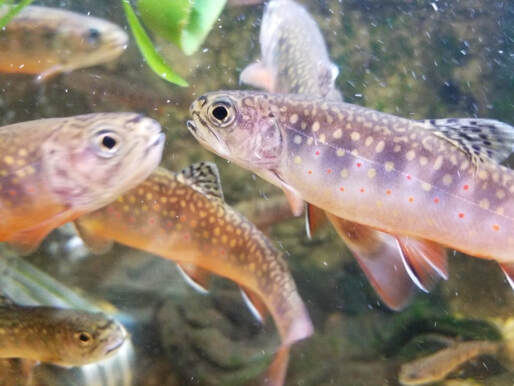Brook Trout (Salvelinus fontinalis)

Common Name: Brook Trout
Scientific Name: Salvelinus fontinalis
Physical Description: Brook Trout can grow up to 10 inches in length. They have a dark, green to gray dorsal side with lighten spots on it. Their ventral, or underside and fins have a pink to orange color that develops more as they age.
Habitat: Brook Trout are born in cold, freshwater streams. As adults they live in larger streams, lakes, and/or saltwater bodies for coastal populations. The coastal populations are referred to as anadromous fish, fish that spend most of their life in saltwater but migrate to freshwater to spawn.
Range: They are native to eastern North America, from the Great Lakes and Maine down to Georgia and through the Appalachian Mountains1.
Diet: They eat insects, worms, and small fish.
Lifespan: They live 2-3 years on average2.
Social Structure: Brook Trout live in schools, sometimes with other species of fish. They spawn in the fall with females laying hundreds of eggs in depressions called redds. Males will then fertilize them with their clouds of milt. Eggs hatch in the spring when waters reach a certain temperature. This also a synchronous hatch across areas within a temperature gradient.
Status: Unlisted
Other: The Brook Trout are seasonal residents of Connecticut’s Beardsley Zoo. They are raised each winter and spring in our Trout in the Classroom program with local Bridgeport students. Fish come as small fry from a hatchery and upon reaching 3-5 inches in length, are released to the Pequonnock River outside the zoo to support conservation efforts and population restoration.
1 https://www.fws.gov/species/brook-trout-salvelinus-fontinalis
2 https://www.nwf.org/Educational-Resources/Wildlife-Guide/Fish/Brook-Trout
Scientific Name: Salvelinus fontinalis
Physical Description: Brook Trout can grow up to 10 inches in length. They have a dark, green to gray dorsal side with lighten spots on it. Their ventral, or underside and fins have a pink to orange color that develops more as they age.
Habitat: Brook Trout are born in cold, freshwater streams. As adults they live in larger streams, lakes, and/or saltwater bodies for coastal populations. The coastal populations are referred to as anadromous fish, fish that spend most of their life in saltwater but migrate to freshwater to spawn.
Range: They are native to eastern North America, from the Great Lakes and Maine down to Georgia and through the Appalachian Mountains1.
Diet: They eat insects, worms, and small fish.
Lifespan: They live 2-3 years on average2.
Social Structure: Brook Trout live in schools, sometimes with other species of fish. They spawn in the fall with females laying hundreds of eggs in depressions called redds. Males will then fertilize them with their clouds of milt. Eggs hatch in the spring when waters reach a certain temperature. This also a synchronous hatch across areas within a temperature gradient.
Status: Unlisted
Other: The Brook Trout are seasonal residents of Connecticut’s Beardsley Zoo. They are raised each winter and spring in our Trout in the Classroom program with local Bridgeport students. Fish come as small fry from a hatchery and upon reaching 3-5 inches in length, are released to the Pequonnock River outside the zoo to support conservation efforts and population restoration.
1 https://www.fws.gov/species/brook-trout-salvelinus-fontinalis
2 https://www.nwf.org/Educational-Resources/Wildlife-Guide/Fish/Brook-Trout






